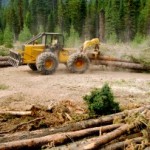Analysts say Montana mills may be near sustainable level
Posted: October 14, 2011By Rob Chaney of the Missoulian
After several years of contractions and downturns, what remains of Montana’s timber industry may find a sustainable level ofwork.
“All the mills have their log prices in line with what the lumber prices are,” said Craig Rawlings, publisher of Smallwood News and owner of Timber Buy-Sell.com. “They’ve curtailed, tightened their belts, and they are in balance with what the market conditions are.”
The 10 large mills and roughly 4,000 wood products workers in Montana have benefited from a shift in major lumber markets, Rawlings said. Pacific Coast states have transferred much of their log inventories to export sales, leaving more of the domestic lumber market open to Montanans. They’re also moving into energy production areas like biofuels and pellet production.
But the long-term outlook for the industry holds little growth. For 2009, the latest year with data available, the timber industry made up 1.2 percent of the state’s employment. That included everything from forestry and logging to sawmill work and cabinet manufacturing. In total, that represented about 4,123 of the state’s 341,357 private employment jobs.
That number was 7,541 jobs in 1998. That was toward the end of the top production years for national forest land, when Forest Service Region 1 produced 11 billion board feet of lumber a year. That figure is closer to 2.4 billion board feet in 2011, according to Region 1 Forester Leslie Weldon.
In Montana, the remaining mills have a capacity of handling about 100 million cubic feet of lumber a year, but the forests are producing about 300 million cubic feet, according to Todd Morgan, director of forest industry research at the University of Montana Bureau of Business and Economic Research.
“There’s not that much timber being harvested,” Morgan said. “Land owners aren’t anxious to sell with prices this low. It’s still a bad time to be a logger. This is the fifth year in row of declining prices.”
And getting at those logs also remains a challenge.
“When you look at forest inventory information, there’s far more dead-and-dying and net growth to assume there’s more than enough timber to support the remaining infrastructure we have,” said Montana State Forester Bob Harrington. “But for the work that’s actually getting done – that would translate to a reasonable supply close to these remaining mills – we’re not quite there yet. A lot of the mills are really struggling to have a one-week or two-week supply in their log yard.”
What’s missing, Harrington said, was a suitable level of approved timber sales and stewardship projects that mills can bid on. Montana Wood Products Association executive vice president Julia Altemus agrees.
“That’s really a matter of supply, and the material is not moving out of the forest at a sustainable rate,” Altemus said. “If the supply is there, we’ll find markets. Private landowners supply 29 (percent) or 30 percent of the inventory, and that’s down because of the market and price of stumpage. But it’s the Forest Service that supply 8 (percent) to 14 percent of the wood fiber, and they manage 60 percent of the land. That’s been an issue for decades.”
While Montana’s timber sector shrunk 45.3 percent in the past decade, non-timber jobs in Montana grew 25 percent, from 269,603 to 337,234.
Service-sector jobs, the largest slice, comprised 84 percent of the state’s jobs in 1998 and grew slightly to 86.2 percent in 2009. The category includes a wide range of white-collar work from professional trades, financial advising, education and hospitality. Its annual wages averaged $31,161, with hospitality jobs bottoming out at $14,480 and financial activities topping at $43,732.
Timber jobs were relatively high-paying. Montana’s 2010 average annual private salary was $33,236. But the average annual timber wage was $35,546 for loggers and $38,157 for wood products manufacturing work, according to the U.S. Bureau of Labor Statistics.
As far as total income was concerned, that worked out to 1.25 percent of Montanans’ total labor earnings, according to University of Montana economics professor Tom Power. In 1986, that figure was 3.2 percent.
And the projected growth rate for those timber jobs remains virtually flat. According to the state Department of Labor and Industry’s Research and Analysis Bureau, foresters, loggers and log graders could expect about a 1 percent annual increase in jobs over the coming decade. Logging equipment operators were forecast to stay flat or decline slightly in the same period.
A new emphasis in the Forest Service on clearing hazardous fuels around developed areas could keep a steady supply of work for the remaining logging and milling workers.
“If the Forest Service was to focus on where the transportation infrastructure already is, where investments in plantations are, where harvest coincides with protecting densely settled areas from wildfire, we might harvest more timber than we are now,” Power said.


